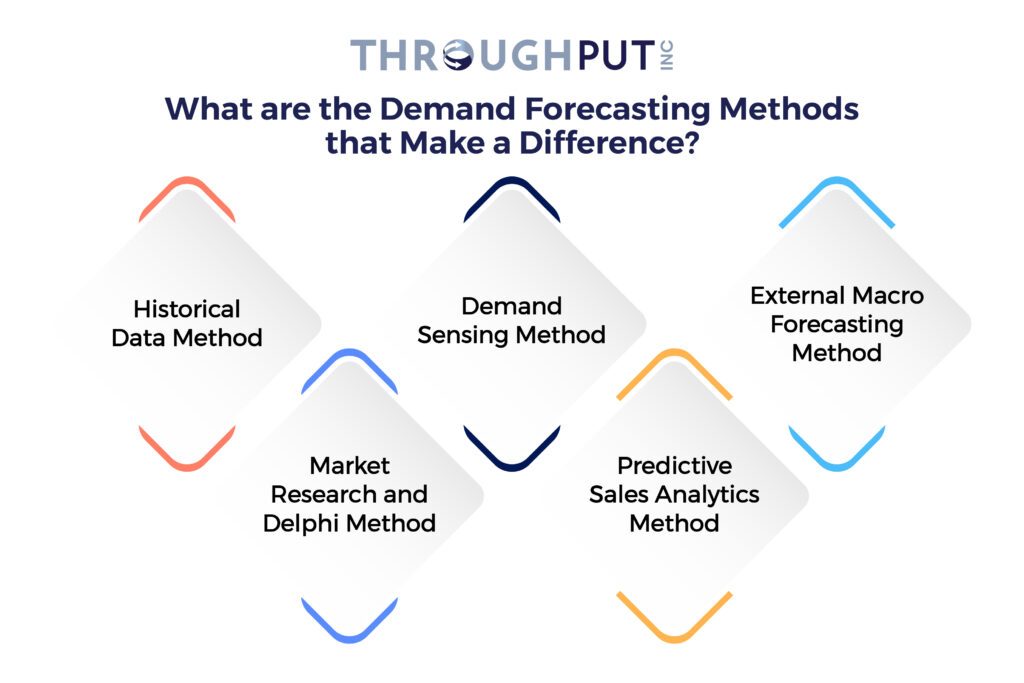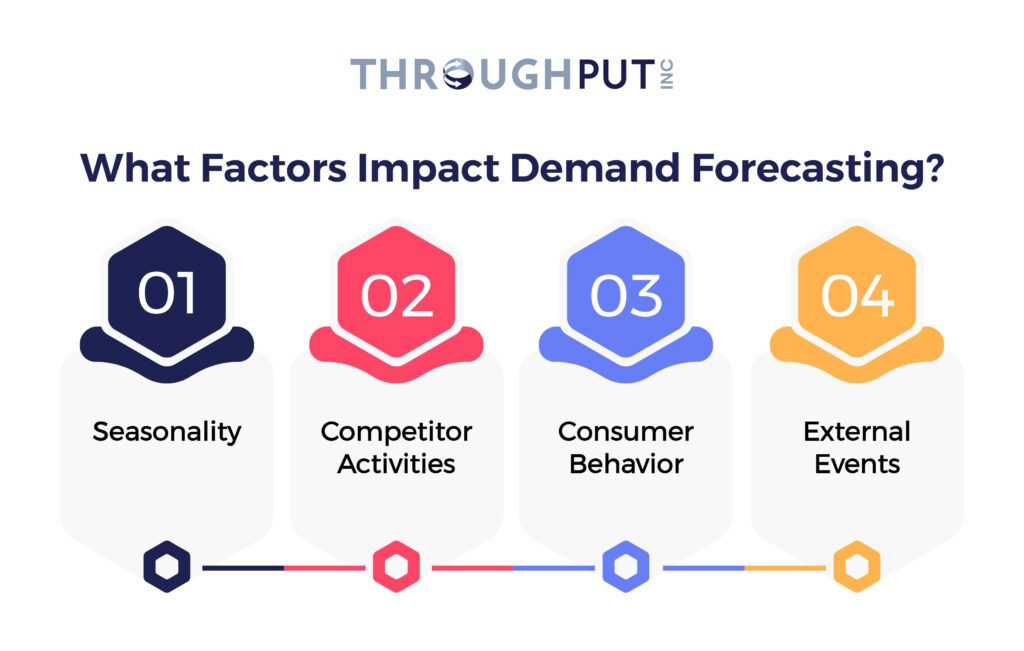5 Demand Forecasting Methods that Accurately Predict Demand

Keeping up with demand and market trends challenges most supply chain operators, making accurate demand forecasting crucial for operational efficiency.
Understanding and applying the right demand forecasting methods helps businesses navigate fluctuating demand cycles more effectively. Accurately forecasting sales with fluctuating demand cycles is difficult to achieve, which is why businesses now rely on AI demand forecasting software and other demand forecasting solutions to improve accuracy and optimize inventory levels. The lack of forecasting accuracy can easily spill hardship into other departments.
Supply chain operators need to take a step back and closely examine their demand forecasting process to optimize supply chain operations, reduce costs, and improve customer satisfaction.
Since demand forecasting is more than just looking at historical data and making educated guesses, we’ve compiled our know-how in an “all-you-need-to-know” blog post to shed some light on this topic and provide actionable advice.
We’ll explore the art and science of demand forecasting, including proven methods and techniques that can help you create more accurate forecasts and gain a competitive advantage in today’s complex global economy.
Let’s start with the definition.
What is Demand Forecasting?
Demand forecasting is the process of predicting future demand for a product or service, helping businesses plan resources, optimize supply chain operations, and implement data-driven forecasting solutions effectively.
It involves analyzing historical sales data, understanding market trends, and considering various factors influencing demand, such as economic conditions, consumer behavior, and competitor activities.
Accurate demand forecasting enables businesses to optimize their production, inventory management, and pricing strategies, resulting in maximized profits and customer satisfaction.
What are the Benefits of Accurate Demand Forecasting?
The benefits of accurate demand forecasting include optimized inventory levels, improved supply chain resilience, and reduced carrying costs. Using an AI-based demand forecasting solution can also minimize the risk of stockouts and improve operational efficiency.
Accurate forecasts also enable businesses to plan their production more effectively, ensuring they can meet customer demand while reducing waste and inefficiencies.
Accurately predicting future demand helps businesses better prepare for potential disruptions, such as supply chain disruptions, natural disasters, or changes in consumer behavior.
There’s also the benefit of identifying new market opportunities and developing new products and services that meet customer needs, leading to increased revenue and profitability.
As you can see, there are plenty of benefits to having an accurate demand forecasting system in place. Other than the apparent benefits mentioned earlier, we’ve pinned down the four primary reasons why your supply chain needs precise demand forecasting:
- Improved Decision-making
Reliable forecasts enable businesses to make data-driven decisions about production, inventory management, and pricing strategies, leading to better overall performance. - Reduced Costs
When demand is correctly and accurately anticipated, businesses can optimize their supply chain planning and operations accordingly, reducing overproduction, inventory management, and logistics costs. - Enhanced Customer Satisfaction
Having accurate forecasts allows businesses to effectively meet customer demand, leading to higher customer satisfaction and loyalty. - Increased Profitability
Better decisions reduce costs, improve the supply chain’s bottom line, and increase profitability.
Now that we’ve defined demand forecasting and described how accurate demand forecasts benefit your supply chains, let’s talk about the 5 techniques that will bring your demand forecasting to the next level.

What are the Demand Forecasting Methods that Make a Difference?
The demand forecasting methods that make a difference are the historical data method, market research and delphi method, the demand sensing method, predictive sales analytics method and the external macro forecasting method.
Even though supply chain operators and manufacturers rely on numerous methods spanning from traditional historical data analysis to leveraging advanced machine learning software, here are five tested and proven methods you should implement in your demand forecasting process.

What Are the 5 Key Demand Forecasting Methods?
1. Historical Data Method
Start forecasting demand by analyzing past sales data. Using time series forecasting techniques helps identify trends and seasonality, creating a solid baseline for predictive planning. The historical data method helps you get a rough estimate of demand for your products or services by monitoring past high and low periods of demand. It enables you to get a baseline prediction.
Bonus tip – leverage an AI-powered tool to help you get this baseline in minutes. The solutions powered by emerging technologies like AI (artificial intelligence) or ML (machine learning) take into account your past sales data to make future predictions, so you don’t have to sit and sift through vast chunks of data.
2. Market Research and Delphi Method
What better way to understand consumer demand than talking to and collecting their data? Even though this direct market research approach involves considerable efforts to send out surveys to consumers and collect and analyze their feedback, it also gives you valuable first-hand insights into the minds of consumers.
Similarly, the Delphi method involves talking to market experts to get their opinion on market demand. Both methods involve human interaction and can help you draw on the knowledge of people with different areas of expertise.
The success of these methods depends mainly on your available resources and time. Collecting, collating, and analyzing data collected through these methods is time-consuming and will require expertise to leverage the information in predicting market demand.
Again, make it easier by deploying a data-driven tool that collects data from the end consumer and includes local market knowledge.
Combining market reports with expert knowledge gathered from various sources to provide forecast accuracy makes the task more seamless and faster, making the relevant data available for quick decision-making.
3. Demand Sensing Method
One of the most efficient demand planning methods is demand sensing, which uses machine learning to capture real-time variations in purchase behavior. AI and ML software help you build a data-driven ai in supply chain.
How is that helpful? Demand sensing helps you leverage real-time demand signals so that your supply chain develops the capability to respond quickly to unplanned demand changes.
A powerful, AI-enabled demand sensing tool can help you get real-time visibility into short-term demand, improving service levels and forecast accuracy.
4. Predictive Sales Analytics Method
Predictive supply chain analytics helps you estimate demand and understand what factors drive sales and how consumers will behave under certain conditions. The visibility provided by the combination of ML algorithms and advanced IoT highlights every step of the supply chain to build a demand forecast.
With a proper ML-powered tool, you can aggregate historical and new data from market surveys, social media, customer feedback, ERP, CRM, and others. You can develop predictive models to spot likely consequences and determine relationships between various factors.
5. External Macro Forecasting Method
Analyzing trends in the broader economy and determining how they will affect your business goals helps you understand the larger external market forces. You also get to monitor the availability of raw materials and other factors that can directly or indirectly affect your manufacturing and the overall supply chain.
Like previous methods, AI software helps you gather and analyze the correct information and present it as a proper report.
Accurate demand forecasting can benefit from these techniques, but to achieve ultimate success in forecasting demand, it’s vital to address obstacles and consider the significant variables influencing the predictions.

What are the Challenges of Demand Forecasting?
Demand forecasting challenges are the accuracy of the data used in the forecasting process and the ever-changing market conditions. The success of demand forecasting largely depends on the industry in which the business operates.
One of the most significant challenges of demand forecasting is the accuracy of the data used in the process.
Companies must rely on historical sales data, market trends, and consumer behavior to predict future demand. However, this data is often incomplete or unreliable, making it challenging to make accurate forecasts.
Another challenge of demand forecasting is the ever-changing market conditions. Economic factors, such as inflation and recession, can significantly impact consumer behavior and demand for products. Changes in technology and competition can quickly disrupt the market, making it challenging to predict future demand accurately.
Demand forecasting isn’t a one-time process. It requires continuous monitoring and adjustment to ensure that the forecasts remain accurate.
While there are challenges, companies must understand them, make data-driven decisions, and ultimately, be willing to adapt their strategies and forecasts as market conditions change.
What Factors Impact Demand Forecasting?
Factors that impact demand forecasting are seasonality, competitor activities, consumer behavior and external events.
Other factors like economic changes, such as recessions or booms, can significantly impact consumer behavior and demand for products or services.

Most of the factors that impact demand forecasting fall into one of four major categories:
- Seasonality
Many products or services have seasonal demand patterns, such as winter clothing or holiday gifts, which can take time to forecast accurately. - Competitor Activities
Competitor pricing, promotions, and product launches can impact a business’s product or service demand. - Consumer Behavior
Changes in consumer preferences, tastes, and buying habits can impact demand for products or services. - External Events
Natural disasters, pandemics, and other external events can disrupt supply chains and impact demand for products or services.
Understanding and incorporating these factors into the demand forecasting process helps businesses create more accurate forecasts and better manage their supply chains.
What are Real-life Examples of Demand Forecasting?
Real-life examples of demand forecasting are Johnson & Johnson, FedEx and Nestle.
Demand forecasting has numerous real-life applications in modern supply chain companies. So far, we’ve covered the basics of demand forecasting, now let’s learn from the pros.
Here’s a breakdown of our three real-life examples of accurate demand forecasting implemented in modern supply chains:
Johnson & Johnson
Johnson & Johnson is a multinational corporation that produces medical devices, pharmaceutical, and consumer packaged goods. Johnson & Johnson uses demand forecasting to ensure product availability while managing the complexities of a healthcare supply chain.
FedEx
FedEx, a multinational delivery services company, uses macroeconomic data when forecasting demand to optimize their logistics and distribution network. They analyze historical shipment data and economic indicators to predict package volumes and manage their transportation resources.
Nestle
Nestlé, the world’s largest food and beverage company, uses demand forecasting to manage its supply chain for thousands of products. They use a combination of statistical models and machine learning to predict sales and adjust production accordingly.
As you can see, all major supply chain operators rely heavily on AI-based software to better manage their demand forecasting. This brings us to the final piece of the forecasting puzzle – artificial intelligence in demand forecasting.
How is AI-based Software used in Demand Forecasting?
AI-based software is used in demand forecasting to analyze vast amounts of data and identify patterns and trends that traditional statistical methods may miss.
It comes to no surprise that AI-based demand forecasting software is increasingly being used for demand forecasting in supply chains.
Some benefits of using AI software for demand forecasting include:
- Improved Accuracy: AI software can analyze large amounts of data and identify patterns and trends that traditional statistical methods may miss, leading to more accurate demand forecasts.
- Faster Processing: AI software can process data much faster than humans, enabling businesses to create demand forecasts more quickly and efficiently.
- Better Decision-making: By providing more accurate and timely demand forecasts, AI software can help businesses make better decisions about production, inventory management, and pricing strategies.
- Reduced Costs: AI software optimizes supply chain operations and reduces overproduction and inventory management costs, resulting in reduced costs and increased profitability.
How to Choose the Right Demand Forecasting Software
Choosing the right demand forecasting software can transform how your business predicts and responds to market fluctuations. The right tool should not only deliver accurate forecasts but also align with your operational goals and data ecosystem.
Here’s a quick checklist to help you evaluate the best-fit solution for your business:
- Integration Capabilities – Ensure the software easily integrates with your ERP, CRM, and inventory systems for unified data visibility.
- AI & Machine Learning Support – Choose a solution that leverages AI and ML for pattern recognition, anomaly detection, and continuous forecast improvement.
- Real-Time Demand Sensing – Opt for tools that can capture and analyze real-time signals from POS data, social media, and market feeds.
- Scenario Planning & Simulation – The best demand forecasting software lets you model “what-if” scenarios and stress-test your supply chain strategies.
- Ease of Use & Visualization – An intuitive interface with clear dashboards and data visualization capabilities makes decision-making faster and more effective.
- Scalability & Flexibility – As your business grows, the solution should seamlessly handle larger datasets and expanding product lines.
Pro Tip: Look for AI-powered demand forecasting software that not only predicts demand but also recommends proactive actions to rebalance your supply chain in real time.
If you’re seeking a robust, AI-driven platform that checks all these boxes — ThroughPut’s demand forecasting solution provides real-time visibility, predictive accuracy, and data-driven insights that help you optimize end-to-end operations.
Future Trends in Demand Forecasting
The future of demand forecasting is rapidly evolving as businesses strive for agility, accuracy, and resilience in a volatile global market. Emerging technologies are reshaping how organizations collect, analyze, and act on data to stay ahead of demand fluctuations.
Here are the top trends shaping next-generation demand forecasting:
- Generative AI for Scenario Modeling – Advanced AI models are simulating multiple market conditions to predict demand under uncertainty.
- Real-Time Analytics through IoT – Smart sensors and connected devices feed live data from production lines, warehouses, and retail outlets for instant forecasting updates.
- Probabilistic Forecasting – Instead of relying on single-point predictions, companies are adopting probability-based forecasting to plan for multiple outcomes.
- Digital Twins in Supply Chain – Virtual replicas of supply chains enable real-time forecasting, risk testing, and performance optimization before actual execution.
- Sustainability and ESG Forecasting – Companies now forecast not only demand but also the environmental impact of their operations, aligning business goals with sustainability targets.
As these innovations become mainstream, businesses using AI-powered demand forecasting software will gain a decisive advantage — combining speed, accuracy, and resilience across every supply chain node.
Throughput’s Demand Forecasting Solution
With the supply chain uncertainties on the rise, and demand volatility creating crisis testing the resilience of every business, those adopting data-driven demand forecasting solutions have a better chance of adapting to the change and responding to the changes in demand.
For this, you’ll require an all-powerful tool that can not only capture demand signals and fluctuations in real-time but also adjust the existing predictions to accommodate the changes.
ThroughPut’s AI-powered demand planning and forecasting tool, can help you accurately analyze and correlate demand insights.
It uses historical data, analyzes short-term and external market trends, and identifies and predicts future demand patterns so you can get a 360-degree view of market demand for your products and services and adapt your demand plans to the changes in patterns.
Explore how ThroughPut can make a difference to your demand planning efforts. Talk to the experts at ThroughPut and book your demo today!
FAQ On Demand Forecasting
Q1: How can AI-powered demand forecasting help maintenance teams reduce unplanned downtime?
A: By predicting part and equipment demand more accurately, AI-driven forecasting ensures critical spare parts and consumables are always available when needed. This minimizes reactive maintenance, prevents line stoppages, and optimizes asset utilization.
Q2: How does better demand forecasting improve maintenance scheduling and workforce planning?
A: Accurate demand forecasts enable maintenance leaders to plan preventive maintenance windows aligned with production demand cycles — reducing idle labor and maximizing technician efficiency.
Q3: How does AI-driven demand forecasting ensure a steady supply of materials without overstocking?
A: Through real-time analysis of demand signals, supplier lead times, and consumption patterns, AI forecasting software helps balance material availability with working capital goals — maintaining supply continuity without tying up excess inventory.
Q4. What measurable supply performance gains can companies achieve with ThroughPut.AI’s demand forecasting?
A: Companies have reported up to 30% faster material replenishment, 20–25% lower excess stock, and significant improvements in supplier responsiveness, enabling smoother operations and reduced capital blockage.
Q5. How can demand forecasting improve sourcing decisions and supplier negotiations?
A: Reliable demand forecasts give sourcing leaders data-backed visibility into future material requirements, enabling better long-term contracts, volume-based discounts, and reduced spot buying.
Q6. How does predictive demand data help mitigate supplier risks?
A: By continuously analyzing external and internal demand shifts, AI forecasting tools identify early risk signals like supplier delays or market shortages — allowing sourcing heads to diversify suppliers or adjust order volumes proactively.
Q7. What’s the ROI timeline for implementing AI-based demand forecasting in industrial operations?
A: Most organizations see measurable ROI within 90 days, through reduced stockouts, improved OEE, and enhanced material flow visibility across maintenance, supply, and sourcing functions.
Q8. How does ThroughPut.AI integrate with existing ERP and MRP systems?
A: ThroughPut.AI’s platform integrates seamlessly with major ERP systems (SAP, Oracle, etc.), automating data flow for real-time insights without disrupting existing workflows.
Q9: What demand forecasting strategies help industrial supply heads maintain optimal stock levels?
Industrial supply heads can leverage AI-driven demand forecasting to synchronize inventory levels with actual consumption patterns across sites and departments. By combining time-series analysis with predictive algorithms, supply teams avoid both overstock and stockouts. This enhances product availability for critical operations while reducing inventory holding costs and supporting just-in-time (JIT) initiatives for high-mix, high-volume environments.

